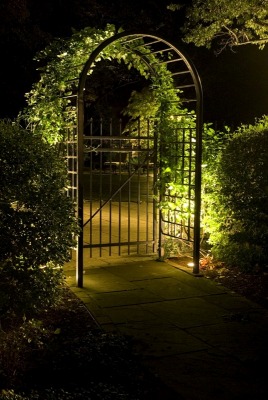At a minimum, bulbs (lamps) are going to have to be replaced to ensure uniformity in the lighting scheme. To ensure proper operation, a yearly service is the minimum recommended with periodic checks suggested.
The following are a few reasons as to why periodic attention should be considered:
- Build up of accumulated leaves and debris at or on the fixtures
- Impurities in the air will accumulate on the lens surface/glass
- Intrusion of insects into on around the light fixtures/housing
- Inadvertent damage by the activities that go on around the area
- Wiring affected by gardening activities in proximity to the lights
- Growth of plants affecting or obscuring light from fixture beam
Basic regimen for assurance of properly operating lighting system – performed on an annual basis

Cleaning:
Removal of any accumulated leaves or debris on or at the base of the light fixtures. Cleaning of the lens with a solution of one vinegar to nine parts water. Both sides of the lens should be cleaned to enhance full clarity of the light through the glass. Any materials that maybe encrusted on the lens can be scraped clean with a razor blade. Depending on the type of material that the fixture is made of, this will dictate the cleaning agent that should be used for fixture cleaning. Care should be taken not to effect the natural weathering (patina or Verdi) appearance that is desired and creates a garden like appearance.
Pruning and trimming:
Plants depending on species, age, and location have varying growth rates and attention to control of these various plants is going to be required to assure uniform lighting scheme. Any plant growing in close proximity to existing fixtures should be cut back or pruned to the point where the season growth will have little or no influence of the light distribution from the fixture. Consideration should also be given to shadows from plantings so as not to eliminate a desired effect that maybe incorporated intentionally into the lighting scheme. Close attention to downlighting from trees will often create a moonlight effect and this will require diligence when trimming or pruning tree branches so as not to alter or affect the desired appearance.
Adjustments/Repositioning:
With a maturing landscape, it may become necessary to reposition and in some situations relocate fixtures because of plant growth. A well installed system will have a service loop or additional electrical cord at the base of the fixture. The purpose is to allow you to easily reposition or move the fixture now that the original planting has matured and small changes have to be made.
Controls/Timing:
Visual check of the transformer and the timing mechanism is imperative. Care must be used when inspecting the interior of the transformer because of the possibility of line voltage connections. Insect intrusion is a quite common place to make provisions to see that eggs or nesting material is removed and the unit is free of any accumulated debris. Units with photo sensor devices can be tested by activating the transformer and putting electrical tape over the end of the unit simulating nightfall. Low voltage wiring connections at transformer should be checked at terminal blocks to ensure connections are tight and corrosion is not present at these locations. If a testing device is available, voltage on the loads and amperage at the transformer should be checked to ensure all are within proper range.
